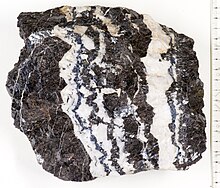

In mining, gangue (/ɡæŋ/)[1] is the commercially worthless material that surrounds, or is closely mixed with, a wanted mineral in an ore deposit. It is thus distinct from overburden, which is the waste rock or materials overlying an ore or mineral body that are displaced during mining without being processed, and from tailings, which is rock already stripped of valuable minerals.
The separation of valuable mineral from gangue minerals is known as mineral processing, mineral dressing, or ore dressing. It is a necessary, and often significant, aspect of mining. It can be a complicated process, depending on the nature of the minerals involved.[2] For example, galena, an ore of lead, is usually found in large pieces within its gangue, so it does not normally need extensive processing to remove it; but cassiterite, the chief ore mineral of tin, is usually disseminated as very small crystals throughout its gangue, so when it is mined from hard rock, the ore-bearing rock first needs to be crushed very finely,[3] and then has to be subjected to sophisticated processes to separate the ore.
For any particular ore deposit, and at any particular point in time, the concentration of the wanted mineral(s) in the gangue material will determine whether it is commercially viable to mine that deposit. The ease with which the wanted mineral(s) can be separated from gangue minerals also plays an important part. Early mining ventures, having relatively unsophisticated methods, often could not achieve a high degree of separation, so large quantities of minerals found their way into the waste mineral dumps of mines. As the value of a mineral increases, or when new and cheaper means of processing the ore to extract the wanted mineral(s) are introduced, it may become worthwhile to rework such old dumps to retrieve the wanted minerals they still contain.
- ^ "gangue: definition of gangue in Oxford dictionary (American English) (US)". www.oxforddictionaries.com. Archived from the original on May 5, 2013. Retrieved 2016-02-06.
- ^ A number of historical examples are detailed in: Hardesty, Donald L. (2010). Mining Archaeology in the American West: A View from the Silver State. University of Nebraska Press. pp. 70–91. Archived from the original on 2016-03-07. Retrieved 2017-08-28.
- ^ Palmer, Marilyn; Neaverson, Peter (1994). Industry in the Landscape 1700–1900. New York: Routledge. p. 77. Archived from the original on 2016-03-10. Retrieved 2017-08-28.